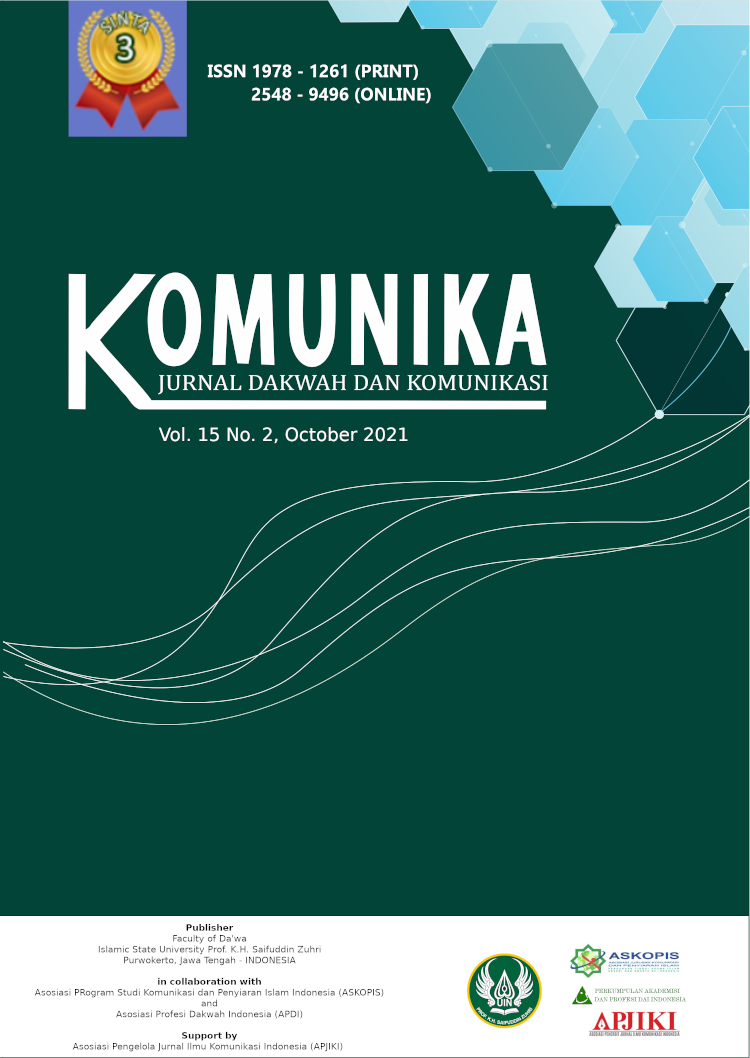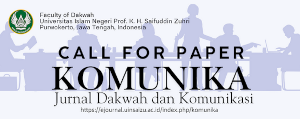Representation of Female Superhero and Gender Roles in the Avengers: Endgame
DOI:
https://doi.org/10.24090/komunika.v15i2.4580Keywords:
Representation, Female Superhero, Stereotype, Semiotics, Film, Gender RolesAbstract
This paper aims to present the study about the representation of female superhero characters and gender roles in Avenger: Endgame. This study is justified to be important as females usually have their stereotypical representation in mass media, including film. Thus, it is crucial to explore and analyze whether or not female superheroes are depicted similarly. There are three main characters analyzed in this movie, namely Gamora, Black Widow, and Nebula. This study applies the semiotics method with a qualitative approach whereby Roland Barthes Semiotics is employed as the theoretical foundation of the analysis and strategy in this study. The research has focused on the representation of gender roles and physical manifestations of the characters in the film. The study has shown that (i) each of the characters plays several roles based on the context of the story, (ii) the balance of power between male and female are not equally distributed, and lastly (iii) Gamora and Nebula being different species than Black Widow which is human, had their appearance interpreted to possess a human-like body, yet the pattern of body size among these three-female superheroes sends a message that this body shape is the “ideal and desirable” body type.Downloads
Download data is not yet available.
References
Alzahrani, F. (2016). The Portrayal of Women and Gender Roles in Films. International Journal of Scientific & Engineering Research, Vol. 7 (4), 533-534.
Arofat, S. (2013). Representasi Perempuan dalam Film Bernuansa Islami. Refleksi, Vol. 13(4), 495-528.
Baran, S. J. (2014). Introduction to Mass Communication: Media Literacy & Culture. Boston: McGraw-Hill Education.
Basarah, F. F. (2019). Feminisme dalam Web Series “Sore-Istri dari Masa Depan” (Analisis Wacana Sara Millis). Widyakala Journal, Vol. 6 (2), 110-120.
Blackston, A. M. (2003). Gender Role & Society. Miller, J. R., Lerner, R. M., & Schiamberg, L. B. (Eds.) Human Ecology: An Encyclopedia of Children, Families, Communities, and Environments, 335-338. Santa Barbara, CA: ABC-CLIO.
Bordo, S. (2003). Unbearable Weight: Feminism, Western Culture, and the Body (tenth anniversary edition). Berkeley, CA: University of California Press.
Bouzida, F. (2014). The Semiology Analysis in Media Studies: Roland Barthes Approach. Proceedings of SOCIOINT4-International Conference on Social Sciences and Humanities, 1001-1007.
Briandana, R. & Hajariah, S. (2013). Gender and the Action Film: Question of Female Heroism (Analysis of Female Masculinity of the Female Heroic Character). Jurnal Visi Komunikasi, Vol. 12 (2),
183-198.
Butler, J. (1990). Gender Trouble: Feminism and the Subversion of Identity. Great Britain: Routledge, Chapman & Hall.
D'Amore, L. M. (2012). The Accidental Supermom: Superheroines and Maternal Performativity, 1963– 1980. The Journal of Popular Culture, Vol. 45(6), 1226-1248.
Danesi, M. (2004). Pesan, Tanda dan Makna. (Setyarini, A. & Piantari, L. L, Trans.). Yogyakarta: Jalasutra
Dunne, M. (2006). The representation of women in comic books, post WWII through the radical 60s. PSU McNair Scholars Online Journal, Vol. 2(1), Article 20.
Eriyanto. (2001). Analisis Wacana: Pengantar Analisis Teks Media. Yogyakarta: LKIS.
Emad, M. C. (2006). Reading Wonder Woman’s body: Mythologies of gender and nation. Journal Of Popular Culture 39(6), 954-984.
Gablaski, J. (2020). Super or Sexist? The Evolution of Female Superheroes in Comics in Film. Honors Theses. 84. https://digitalcommons.assumption.edu/honorstheses/84
Gerard, M. (2018). Black Widow: Female Representation in the Marvel Cinematic Universe. Polymath: An Interdisciplinary Arts and Sciences Journal, pp. 27-53.
Hall, S. (2009). Representation: Cultural Representation & Signifying Practices (p. 15). California, US: Sage Publication.
Ito, K. (1994). Image Of Women in Weekly Male Comic Magazine in Japan. The Journal of Popular Culture, Vol. 27(4), 81-95.
Krahn, K. M. (2015). Reel Women: Gender Stereotypes in Films. Master’s Theses, and Doctoral Dissertations, and Graduate Capstone Projects, Eastern Michigan University.
Kunsey, I. (2018). Representations of Women in Popular Film: A Study of Gender Inequality in 2018. Elon Journal of Undergraduate Research in Communications, Vol. 10(2), 27-38.
Lester, P. M., & Ross, S. D. (2003). Images that injure: Pictorial stereotypes in the media. Westport, Conn: Praeger.
Majhi, G. 2017. Paradox of Gender Equality in Hollywood Superhero Movies. Arts & Education International Research Journal, Vol. 4(2), 5-9.
Misiroglu, G., Sanderson,. Peter and Eury,. Michael (2017, February 1). Superhero. Encyclopedia Britannica. https://www.britannica.com/art/superhero
Muhibbin, Z. (2011). Wanita dalam Islam. Jurnal Sosial Humaniora, Vol. 4(2), 109-120.
Murphy, J. N. (2015). The role of women in film: Supporting the men -An analysis of how culture influences the changing discourse on gender representations in film. Journalism Undergraduate Honors Theses.
Murphy, K. (2016). Analyzing Female Gender Roles in Marvel Comics from the Silver Age (1960) to the Present. Discussion: The Undergraduate Research Journal of CWRU, 8-17.
Pickering, M. (2016). Stereotyping and Stereotypes. In R. P. JohnStone, The Wiley Blackwell Encyclopedia of Race, Ethnicity, and Nationalism, (First Edition). John Wiley & Sons, Ltd.
Scheiner-Fisher, C. (2013). The Inclusion Of Women's History In The Secondary Social Studies Classroom. Electronic Theses and Dissertations, 2004 – 2009. University of Central Florida.
Sebastian, R. (2019). Women and Action: The Representation of Hollywood Superhuman Film Wonder Woman. https://www.researchgate.net/publication/343627491_Women_and_Action_The_Representation_of_Hollywood_Superhuman_Film_Wonder_Woman
Stewart, C & Kowaltzke, A. (1997). Media New Ways and Meanings. Milton, Qld: John Wiley & Sons Australia.
Thaller, S. (2016). A Feminist Bait-And-Switch: The Hunger Games And The Illusion Of Empowerment. A Journal of Literary Criticism and Analysis. https://www.ohio.edu/cas/parlour/news/hunger-games-illusion-empowerment
Timetoast. Gender Bias in Advertisements Over Time https://www.timetoast.com/timelines/gender-bias-of-advertising-1920 Retrieved in 20 February 2021.
Toni, A. (2019). Wacana Kepemimpinan Perempuan Dalam Film ‘Opera Jawa’ Karya Garin Nugroho. KOMUNIKA: Jurnal Dakwah Dan Komunikasi, 13(2). https://doi.org/https://doi.org/10.24090/komunika.v13i2.2072
Turberville, T. (2016). The Female Justice League: The Misrepresentations of Women n Comic Books. Stylus Knights Write Showcase Special Issue, 71-82.
Wibowo, I. S. W. (2011). Semiotika Komnikasi Aplikasi Praktis Bagi Penelitian dan Skripsi Komunikasi. Jakarta: Mitra Wacan Media.
Zurbriggen, E. L., Collins, R. L., & Lamb, S. (2007). Report of the APA Task Force on the Sexualization of Girls. Washington: American Psychological Association. Portland State University (PSU) McNair Scholars Online Journal 20(1), 81-91.
Arofat, S. (2013). Representasi Perempuan dalam Film Bernuansa Islami. Refleksi, Vol. 13(4), 495-528.
Baran, S. J. (2014). Introduction to Mass Communication: Media Literacy & Culture. Boston: McGraw-Hill Education.
Basarah, F. F. (2019). Feminisme dalam Web Series “Sore-Istri dari Masa Depan” (Analisis Wacana Sara Millis). Widyakala Journal, Vol. 6 (2), 110-120.
Blackston, A. M. (2003). Gender Role & Society. Miller, J. R., Lerner, R. M., & Schiamberg, L. B. (Eds.) Human Ecology: An Encyclopedia of Children, Families, Communities, and Environments, 335-338. Santa Barbara, CA: ABC-CLIO.
Bordo, S. (2003). Unbearable Weight: Feminism, Western Culture, and the Body (tenth anniversary edition). Berkeley, CA: University of California Press.
Bouzida, F. (2014). The Semiology Analysis in Media Studies: Roland Barthes Approach. Proceedings of SOCIOINT4-International Conference on Social Sciences and Humanities, 1001-1007.
Briandana, R. & Hajariah, S. (2013). Gender and the Action Film: Question of Female Heroism (Analysis of Female Masculinity of the Female Heroic Character). Jurnal Visi Komunikasi, Vol. 12 (2),
183-198.
Butler, J. (1990). Gender Trouble: Feminism and the Subversion of Identity. Great Britain: Routledge, Chapman & Hall.
D'Amore, L. M. (2012). The Accidental Supermom: Superheroines and Maternal Performativity, 1963– 1980. The Journal of Popular Culture, Vol. 45(6), 1226-1248.
Danesi, M. (2004). Pesan, Tanda dan Makna. (Setyarini, A. & Piantari, L. L, Trans.). Yogyakarta: Jalasutra
Dunne, M. (2006). The representation of women in comic books, post WWII through the radical 60s. PSU McNair Scholars Online Journal, Vol. 2(1), Article 20.
Eriyanto. (2001). Analisis Wacana: Pengantar Analisis Teks Media. Yogyakarta: LKIS.
Emad, M. C. (2006). Reading Wonder Woman’s body: Mythologies of gender and nation. Journal Of Popular Culture 39(6), 954-984.
Gablaski, J. (2020). Super or Sexist? The Evolution of Female Superheroes in Comics in Film. Honors Theses. 84. https://digitalcommons.assumption.edu/honorstheses/84
Gerard, M. (2018). Black Widow: Female Representation in the Marvel Cinematic Universe. Polymath: An Interdisciplinary Arts and Sciences Journal, pp. 27-53.
Hall, S. (2009). Representation: Cultural Representation & Signifying Practices (p. 15). California, US: Sage Publication.
Ito, K. (1994). Image Of Women in Weekly Male Comic Magazine in Japan. The Journal of Popular Culture, Vol. 27(4), 81-95.
Krahn, K. M. (2015). Reel Women: Gender Stereotypes in Films. Master’s Theses, and Doctoral Dissertations, and Graduate Capstone Projects, Eastern Michigan University.
Kunsey, I. (2018). Representations of Women in Popular Film: A Study of Gender Inequality in 2018. Elon Journal of Undergraduate Research in Communications, Vol. 10(2), 27-38.
Lester, P. M., & Ross, S. D. (2003). Images that injure: Pictorial stereotypes in the media. Westport, Conn: Praeger.
Majhi, G. 2017. Paradox of Gender Equality in Hollywood Superhero Movies. Arts & Education International Research Journal, Vol. 4(2), 5-9.
Misiroglu, G., Sanderson,. Peter and Eury,. Michael (2017, February 1). Superhero. Encyclopedia Britannica. https://www.britannica.com/art/superhero
Muhibbin, Z. (2011). Wanita dalam Islam. Jurnal Sosial Humaniora, Vol. 4(2), 109-120.
Murphy, J. N. (2015). The role of women in film: Supporting the men -An analysis of how culture influences the changing discourse on gender representations in film. Journalism Undergraduate Honors Theses.
Murphy, K. (2016). Analyzing Female Gender Roles in Marvel Comics from the Silver Age (1960) to the Present. Discussion: The Undergraduate Research Journal of CWRU, 8-17.
Pickering, M. (2016). Stereotyping and Stereotypes. In R. P. JohnStone, The Wiley Blackwell Encyclopedia of Race, Ethnicity, and Nationalism, (First Edition). John Wiley & Sons, Ltd.
Scheiner-Fisher, C. (2013). The Inclusion Of Women's History In The Secondary Social Studies Classroom. Electronic Theses and Dissertations, 2004 – 2009. University of Central Florida.
Sebastian, R. (2019). Women and Action: The Representation of Hollywood Superhuman Film Wonder Woman. https://www.researchgate.net/publication/343627491_Women_and_Action_The_Representation_of_Hollywood_Superhuman_Film_Wonder_Woman
Stewart, C & Kowaltzke, A. (1997). Media New Ways and Meanings. Milton, Qld: John Wiley & Sons Australia.
Thaller, S. (2016). A Feminist Bait-And-Switch: The Hunger Games And The Illusion Of Empowerment. A Journal of Literary Criticism and Analysis. https://www.ohio.edu/cas/parlour/news/hunger-games-illusion-empowerment
Timetoast. Gender Bias in Advertisements Over Time https://www.timetoast.com/timelines/gender-bias-of-advertising-1920 Retrieved in 20 February 2021.
Toni, A. (2019). Wacana Kepemimpinan Perempuan Dalam Film ‘Opera Jawa’ Karya Garin Nugroho. KOMUNIKA: Jurnal Dakwah Dan Komunikasi, 13(2). https://doi.org/https://doi.org/10.24090/komunika.v13i2.2072
Turberville, T. (2016). The Female Justice League: The Misrepresentations of Women n Comic Books. Stylus Knights Write Showcase Special Issue, 71-82.
Wibowo, I. S. W. (2011). Semiotika Komnikasi Aplikasi Praktis Bagi Penelitian dan Skripsi Komunikasi. Jakarta: Mitra Wacan Media.
Zurbriggen, E. L., Collins, R. L., & Lamb, S. (2007). Report of the APA Task Force on the Sexualization of Girls. Washington: American Psychological Association. Portland State University (PSU) McNair Scholars Online Journal 20(1), 81-91.

Downloads
Published
2021-10-01
Issue
Section
Articles
License
Authors who publish with this journal agree to the following terms:
- Authors retain copyright and grant the journal right of first publication with the work simultaneously licensed under a Creative Commons Attribution-ShareAlike 4.0 International License that allows others to share the work with an acknowledgement of the work's authorship and initial publication in this journal.
- Authors are able to enter into separate, additional contractual arrangements for the non-exclusive distribution of the journal's published version of the work (e.g., post it to an institutional repository or publish it in a book), with an acknowledgement of its initial publication in this journal.
- Authors are permitted and encouraged to post their work online (e.g., in institutional repositories or on their website) prior to and during the submission process, as it can lead to productive exchanges, as well as earlier and greater citation of published work (See The Effect of Open Access).
























